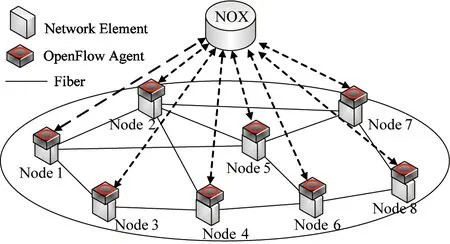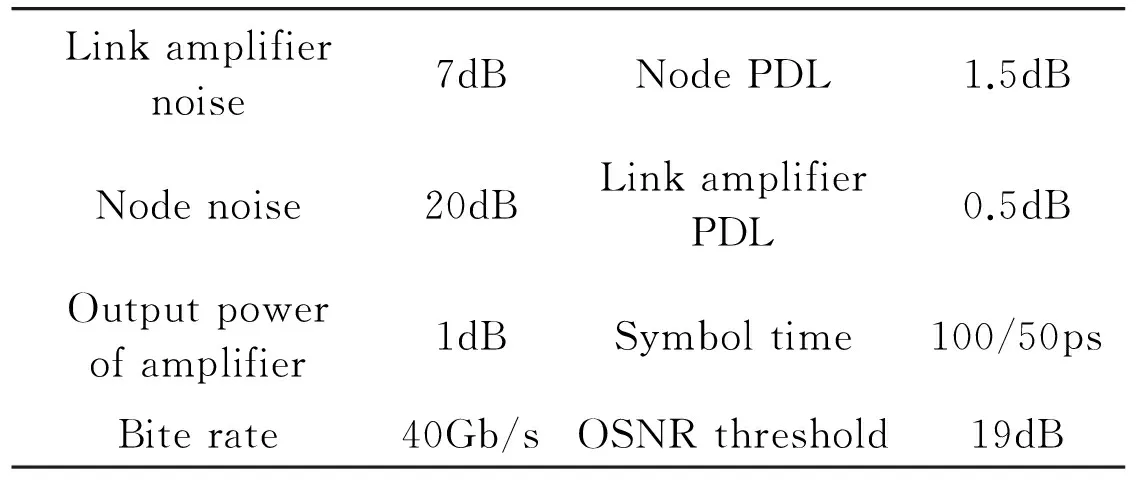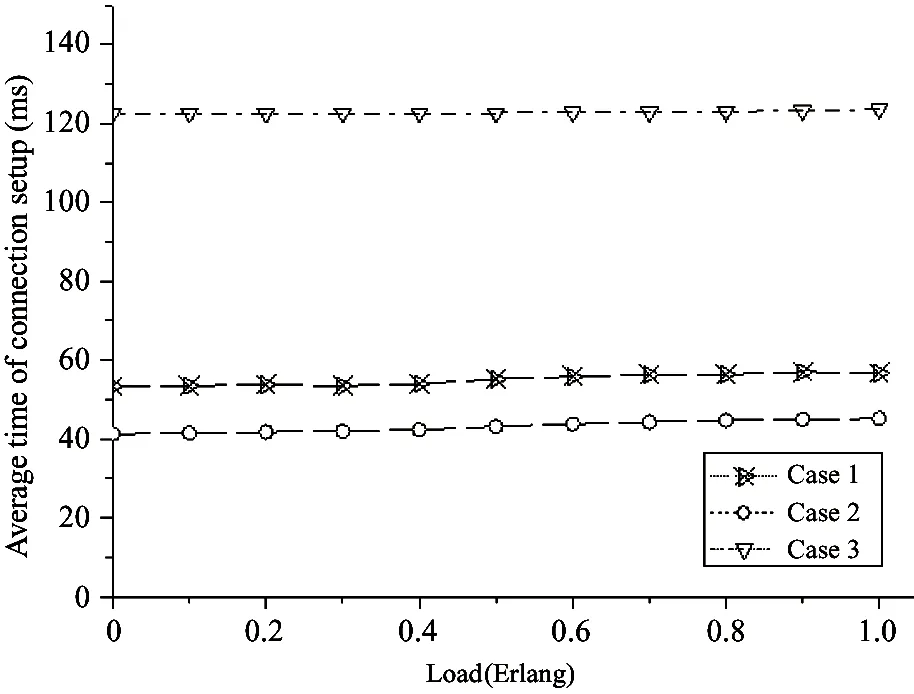Physical layer impairments tolerance based lightpath provision in software defined optical network①
2017-09-25ZhaoXianlong赵羡龙XuXianzeBaiHuifeng
Zhao Xianlong (赵羡龙), Xu Xianze, Bai Huifeng
(*School of Electronic Information, Wuhan University, Wuhan 430079, P.R.China)(**Beijing Smartchip Microelectronics Company Limited, Beijing 102200, P.R.China)
Physical layer impairments tolerance based lightpath provision in software defined optical network①
Zhao Xianlong (赵羡龙)*, Xu Xianze*, Bai Huifeng②**
(*School of Electronic Information, Wuhan University, Wuhan 430079, P.R.China)(**Beijing Smartchip Microelectronics Company Limited, Beijing 102200, P.R.China)
As all-optical networks grow with ever increasing ultra-high speed, the communication quality suffers seriously from physical layer impairments (PLIs). The same problem still exists in software defined optical network (SDON) controlled by OpenFlow. Aimed to solve this problem, a PLIs tolerance based lightpath provision scheme is proposed for OpenFlow controlled optical networks. This proposed approach not only takes the OSNR model to represent those linear PLIs factors, but also introduces those nonlinear factors into the OSNR model. Thus, the proposed scheme is able to cover most PLIs factors of each optical link and conduct optical lightpath provison with better communication quality. Moreover, PLIs tolerance model is also set up and considered in this work with some necessary extension to OpenFlow protocols to achieve better compatibility between physical layer impairments factors and various services connections. Simulation results show that the proposed scheme is able to get better performance in terms of packet loss rate and connection setup time.
OpenFlow, physical layer impairments (PLIs), tolerance model, lightpath provision
0 Introduction
The great progress of software defined network (SDN) technologies has already brought bright future for optical networks to become software programmable[1]. And great effort has been made to develop the SDN technology by the Open Networking Foundation (ONF) into the demain of optical network, which has become the main trend of future optical networks[2,3]. Different from traditional optical network, the concept of software defined optical network (SDON) adopts separation of control plane and transport plane through the logically centralized control plane[4].
As optical networks grow with ever increasing ultra-high speed, the optical communication quality has become increasingly sensitive to various kinds of physical-layer impairments (PLIs), under the circumstance of OpenFlow based optical networks. In fact, PLIs would bring worse optical signal-to-noise ratio (OSNR), bit-error-rate (BER), blocking probability, packet loss rate, and so on. Great efforts have been made to deal with problems caused by PLIs[5]. In Ref.[6], a bi-dimensional quality of service (QoS) differentiation framework, which considers the PLIs and the set up delay as well as the impact of the former on the latter, was reported to implement service differentiation in transparent optical networks. Ref.[7] also presented impairment-aware routing and waveband assignment for efficient optical transport networks, which achieved significant improvement in both impairment satisfaction rate and total network cost. And Ref.[8] conducted deep research on impairment-aware optical networking using OSNR comprehensive awareness model. However, those approaches are far from ideal, since they fail to consider the balance of PLIs among different serviceons, which might cause low utilization of resources or network capacity.
Aimed to overcome the optical communication quality problems caused by PLIs with better efficiency and accuracy, this article proposes a PLIs tolerance based optical lightpath provision scheme in OpenFlow controlled SDON. Different from traditional ones mentioned above, the proposed mechanism is able to build a PLIs tolerance model including both linear parameters and nonlinear ones. Moreover, the proposed scheme is able to combine PLIs tolerance of service and factors of PLIs much more tightly in lightpath provisioning, which makes sure the matching degree between services demands and the OpenFlow controlled ultra high speed optical transport network. Simulation results show that the proposed mechanism greatly improves the performance in terms of the packet loss rate and the lightpath establishment time.
The rest of this paper is organized as follows. Section 1 discusses the related model of physical layer impairments, followed by the description of the architecture of OpenFlow based optical network in Section 2. Furthermore, Section 3 presents the PLIs tolerance based lightpath provision mechanism in detail. Section 4 gives the simulation results. Finally, Section 5 concludes this study.
1 Related model of physical layer impairments
With the development of optical performance monitoring technologies, more efficient ways are provided to detect various parameters of optical signals and resolve degradation problems caused by physical layer impairments.
Generally, there are two categories of physical layer impairments models: the OSNR model and the Q-value model. On one hand, the OSNR model was used in Refs[9-11]. OSNR and the polarization mode dispersion (PMD) were combined together in routing computation and wavelength allocation in Ref.[9], while Ref.[10] dealt with OSNR and PMD separately and judged the eligibility of lightpath by comparing these two factors in terminal node. On the other hand, the Q-value model was adopted in Refs[11,12]. ASE and PMD could be both considered and transformed into BER to judge the usability of lightpath[11]. Furthermore, Q-value factors based routing table for connection establishment was reported[12].
Under the condition of OpenFlow based all-optical network, the control operation of lightpath is centralized in the OpenFlow controller. Therefore, the balance of physical layer impairments must be taken into consideration and a new PLIs tolerance model is necessary in the OpenFlow controller.
2 PLIs tolerace based lightpath provision
2.1 System architecture and basic principle
In general, the SDON architecture comprises a number of OpenFlow switches, one controller, a secure channel that interconnects the switch with the controller, and the OpenFlow protocol for signalling between the switches and the controller[5]. The flow table is one of the core issues of OpenFlow based optical network, which defines and enables the switching operation for lightpath provisioning by interacting between controller and corresponding switches.
In the OpenFlow controlled SDON architecture, there is one single OpenFlow controller to control a number of optical network elements (ONEs). Each network element (NE) is logically equipped with its own OpenFlow agent (OA). The agent is responsible for maintaining communication between controller and NE through the extended OpenFlow protocol, and its functions include compiling controller-to-switch messages to hardware instructors and reporting optical layer status to controller. The architecture of the typical SDON is shown in Fig.1.

Fig.1 Architecture of typical SDON
Moreover, each optical network element is equipped with optical signal impairment collecting module, benefiting from advanced optical performance monitoring technologies. Thus, it is convenient for the OpenFlow agent to be aware of various kinds of parameters values of optical signal from ONE. Additionally, those physical layer impairments can be transformed into the OSNR model in each OpenFlow agent. Therefore, an OSNR tolerance model is designed and embedded in the OpenFlow controller.
The basic principle of the OSNR tolerance model based lightpath provision mechanism comes from the following: on receiving service connection request from client, the controller firstly computes a so-called “virtual lightpath”, then, the controller collects related values of optical physical layer impairments from each OpenFlow agent along the virtual-path by using extended Flow_Mod and Fertures_Reply messages, then, the total OSNR of the whole virtual lightpath is calculated and judgment is made according to the OSNR threshold. If the total-OSNR fails to satisfy the demand, another new virtual path will be computed until the total-OSNR is able to match the requirement for successful lightpath establishment. Then, the controller will trigger all related ONEs to conduct the setup of lightpath through OpenFlow agents using extended Flow_Mod and Fertures_Reply messages.
2.2 Physical layer impairments tolerance model
Generally, PLIs will accumulate during the optical signal transmission, which mainly comes from ASE, crosstalk and FWM[13,14]. Thus, a PLIs comprehensive awareness model of each link between OSNs is setup, which includes various main impairments factors. In this PLIs comprehensive awareness model, the final OSNR of a single link can be obtained by calculating signal power gains and noise power.
Firstly, the noise power caused by the optical switch is given in
(1)
where, Pswtch, irepresents the power of wavelength λ from other fibers in OSN, and ε is the isolation factor. Then, the gain and the noise of ASE must be taken into consideration in Eq.(2). In detail, Famplifieris the noise factor and Gamplifieris the gain of amplifier in the link and Bo is the bandwidth of fiber, and h is the Planck constant and f is the frequency.
(2)
Eq.(3) gives the optical signal loss of the fiber link, in which α is the fiber attenuation factor and d is the distance of the fiber link.
Lfiber=e-α·d
(3)
As to NFWM, NFWM, iis the FWM impact from another wavelength i within the same fiber and NFWMis the sum of NFWM, iin
(4)
Considering both of the optical signal power and the noise power mentioned above, the optical signal power and the noise power of the lightpath can be obtain:

(5)

(6)
Thus, the OSNR value of each link can be got:
Vfinal=Pfinal/Nfinal
(7)
Therefore, this PLIs model of fiber link is set up, which includes ASE, FWM, fiber attenuation and cross-talk in OSN. Moreover, this comprehensive model considers both linear and nonlinear and transforms them into OSNR value, and makes it convenient to compute their impacts using mathematic method with better accuracy, which provides the theoretical basis to the PLIs balance mechanism.
To achieve the balance among multiple services, each service should be assigned with a lighpath, which is most suitble for this service within its OSNR demand. That means: several routes are computated for a service connection request, and the most appropriated one is determined by
Sfinal=MIN{Vfinal(i)-VE}
(8)
where, Vfinal(i) is the final OSNR value along lightpath i, while VEis the threshold OSNR value required by this service connection.
2.3 Procedure of PLIs awareness model based optical multicast
Before the PLIs tolerance based lightpath provision mechanism starts to work, some initiation is required and this detailed procedure is described as follows:
Step 1: The OpenFlow controller sends the FEATURE_REQUEST message to all OpenFlow agents to require OSNR value of each ONE;
Step 2: On receiving the Feature_Request message from the OpenFlow controller, each OpenFlow agent obtains physical-layer impairments from optical performance monitoring module and calculates the OSNR value using Eq.(1)~Eq.(7);
Step 3: Each OpenFlow agent reports the Feature_Reply message with the OSNR value to the OpenFlow controller;
Step 4: The OpenFlow controller collects OSNR values of all links from Feature_Reply message reported by each OpenFlow;
Step 5: The so-called PLIs database is built and kept by the OpenFlow controller to setup a PLIs tolerance model and to form an all-overview of PLIs of the whole network.
Thus, the innitiation is finished and the proposed schem is ready to work. And the working procedure is depicted as follows:
Step 1: On receiving the service connection requrest directly from client, the OpenFlow controller conducts lightpath computation for this connection request, using ONSR values from the the PLIs tolerance model stored in the PLIs database;
Step 2: After the path computation, several lightpaths can be obtained in the OpenFlow controller;
Step 3: The OpenFlow controller calculates total OSNR values of each lightpath, using the PLIs tolerance model by Eq.(8);
Step 4: The OpenFlow controller will judge the usability of each lightpath by comparing the final OSNR value with the threshold value;
Step 5: The OpenFlow controller deletes those lightpath without usability;
Step 6: If there is no usable lightpath, the connection request is blocked by OpenFlow controller. Otherwise, continue to step 7;
Step 7: The most appropriated lightpath is determined by the OpenFlow controller using Eq.(8);
Step 8: The OpenFlow controller immediately sends OPENFLOW_MOD messages to all involved OpenFlow agent, which will configurate the network element to set up the lightpath.
Step 9: All involved OpenFlow agents return FEATURE_REPLY messages to the controller. Thus, the lightpath is successively established.
2.4 Extension of OpenFlow messages
Considering the compatibility of protocol, the OpenFlow Version 1.4 is adopted in this article, which is improved on the basis of the OpenFlow Version 1.3. In OpenFlow 1.4 protocol, the Flow Table synchronization and the bundle message is added to make sure the consistency among messages.
The extension of OpenFlow Version 1.4 protocol to optical domain should be made to realize this proposed OSNR comprehensive-awareness model based lightpath control mechanism. The protocol extension is on the basis of Flow_Mod and Feature_Request/Reply messages, as shown in Fig.2.
As Fig.2 shows, extra fields are added after the original OpenFlow 12-tuple as fields from packets used to match against flow entries. Here, “Flow” means a wavelength or a sub-wavelength, rather than a number of packets. The “Wavelength” field is used to denote the occupied wavelength. The “Port i” and “Port j” fields indicate physical port connection with neighbour ONEs. These two fields are responsible for topology-discovery function for NOX controller. The “Flow ID” indicates various applications, each occupying a designated light path.

Fig.2 Extended fields to match against flow entries
3 Simulation results and analysis
To evaluate the proposed scheme, an OpenFlow controlled all-optical network simulation platform with one NOX controller, one client, 14 optical network elements and 21 bidirectional fibre links is built, where the NSF net topology is adopted. Assume that there are 16 wavelengths in each link with distance of 82km and with speed of 10Gb/s. Moreover, the input power is set to be 0dB and the the fiber attenuation factor is 0.22dB/km, while gain of amplifier is 18dB. During the simulation, the client is responsible for producing connection requests, where the connection request comes with the Poisson distribution and its duration keeps the negative exponential distribution.
In this simulation, main parameters are set as shown in Table 1. Simulation comparison mainly focuses on performances of packet loss rate and connection establishment time. Case 1 is the OpenFlow controlled lightpath provision with PLIs Balance, while case 2 is the one reported in Ref.[6]. And case 3 is the traditional GMPLS controlled lightpath provision.

Table 1 Main parameters for simulation evaluation
Comparison of the blocking rate is shown in Fig.3. Obviously, case 1 achieves the best result among these three cases. That is because case 1 is able to make sure the quality optical signal of the end-to-end lightpath, enhanced by PLI-balance function. On the other hand, case 2 and case 3 fail to do so. In fact, the OSNR value of the whole lightpath in case 1 is greatly enhanced for the terminal node to receive data packets with best performance among these three cases. As the OSNR value is improved greatly, the packet loss rate can be efficiently reduced, even under condition of high traffic load. Therefore, case 1 can achieve the best performance with much lower packet loss rate than other two.

Fig.3 Comparison of packet loss rate
Fig.4 gives the comparison result on the average time of connection setup. In Fig.4, case 3 takes the longest time to set up end-to-end lightpath, while case 1 and case 2 can complete this operation with much shorter time. The performance result of case 3 is due to the consequent processing approach taken by traditional GMPLS controlled optical network, where the lightpath setup is built node after node along the route using RSVP-TP. Different from case 3, both case 1 and case 2 adopt centralized controlling using OpenFlow protocol, and the establishment of connection is conducted parallel between each pair of nodes. Thus, the time taken by case 1 and case 2 can greatly shorten the establishment of connection. Another observation can be drawn from Fig.4 is that case 1 needs a little longer time when compared with case 2. That is because it needs to collect OSNR values by NOX, from each involved OpenFlow agent.

Fig.4 Comparison of connection establishment time
The comparison of blocking rate is made in Fig.5. It can be observed that case 3 shows the worst average blocking rate performance. That is because lightpath with OSNR value higher than threshold is rejected in case 3, while case 1 and case 2 deal with connection requests with physical-layer impairment factors. Moreover, case 1 proposed in this paper also shows better blocking rate overall when compared with case 2 reported in Ref.[6]. That is because case 1 can allocate the right lightpath with the nearest OSNR value to the threshold, which means long lighpath has higher OSNR and short one will get lower OSNR to make sure the OSNR balance in the whole network. Under comparison, case 2 fails to do so.

Fig.5 Comparison of connection blocking rate
4 Conclusion
An optical PLIs-balance model based lightpath provision mechanism for networks controlled by OpenFlow protocol is proposed. This proposed approach takes the OSNR value of the optical signal along the lightpath into consideration when establishing the lightpath for the connection request using OpenFlow protocol. Moreover, the proposed mechanism makes full advantages of the OSNR monitoring function in each node and assigns the lightpath according to the OSNR value by extending messages of OpenFlow protocol, in order to guarantee the reliable establishment of the lightpath. Experimental results shows that the proposed scheme is able to get better performances in terms of the packet loss rate and the lightpath establishment time.
[ 1] Channegowda M, Nejabati R, Fard M R, et al. First demonstration of an OpenFlow based software-defined optical network employing packet, fixed and flexible DWDM grid technologies on an international multi-Domain estbed. In: Proceedings of the 38th European Conference and Exhibition on Optical Communication, Amsterdam, Netherlands, 2012. 1-3
[ 2] Elbers J P, Autenrieth A. From static to software-defined optical networks. In: Proceedings of the 16th International Conference on Optical Network Design and Modeling (ONDM), Colchester, UK, 2012. 1-4
[ 3] Liu L, Choi H Y, Tsuritani T. First proof-of-concept demonstration of OpenFlow-controlled elastic optical networks employing flexible transmitter/receiver. In: Proceedings of the International Conference on Photonics in Switching, Ajaccio, France, 2012. 1-3
[ 4] Liu L, Tsuritani T, Morita I, et al. Experimental validation and performance evaluation of OpenFlow-based wavelength path control in transparent optical networks. Optics Express, 2011, 19(27): 26578-26593
[ 5] Azodolmolky S, Angelou M, Tomkos I, et al. Impairment-aware optical networking: A survey. WDM Systems and Networks, New York: Springer, 2012. 443-479
[ 6] Zhao J J, Li W, Liu X, et al. Physical layer impairment (PLI)-aware RWA algorithm based on a bi-dimensional QoS framework. Communications Letters, 2013, 17 (6): 1280-1283
[ 7] Jirattigalachote A, Yamada Y, Cavdar C, et al. Impairment-aware routing and waveband assignment for efficient optical transport networks. In: Proceedings of the Optical Fiber Communication Conference, Los Angeles, USA, 2012. 1-3
[ 8] Fidler F, Winzer P J, Thottan M K, et al. Impairment-aware optical networking using cross-layer communication. Journal of Optical Communications and Networking, 2013, 5 (2): 144-158
[ 9] Pedrola O, Bathula B G, Wang M S, et al. Cross-layer enabled translucent optical network with real-time impairment awareness. In: Proceedings of the Global Communications Conference (GLOBECOM), Anaheim, USA, 2012. 2889-2895
[10] Okamoto S, Kisaka Y, Ishihara K, et al. Digital in-band OSNR estimation for polarization multiplexed optical transmission. In: Proceedings of the OptoElectronics and Communications Conference and Photonics in Switching, Kyoto, Japan, 2013. 1-2
[11] Angelou M, Azodolmolky S, Tomkos I. Dynamic impairment-aware routing and wavelength assignment. Optical Networks, 2013, 15(2): 31-51
[12] Ramanujam K. Physical layer impairment aware shared path protection in WDM optical networks. In: Proceedings of the International Conference on Fiber Optics and Photonics, Kharagpar, India, 2014: T3A.58
[13] Xiang J S, Ma S M, Liu Q, et al. Signal-to-noise ratio estimation technology analysis based on LDPC code over multiplicative noise channel for optical communication. Journal of Optoelectronics, Laser. 2013, 24(12): 2322-2327(In Chinese)
[14] Guo H Y, Xu B, Qiu K. A combination algorithm of channel equalization and frequency offset estimation for optical burst-mode coherent communication. Journal of Optoelectronics, Laser, 2013, 24(9): 1714-1719(In Chinese)
Zhao Xianlong, born in 1973. He is the Ph.D candidate in Wuhan University. His research field includes the software defined network and optical networks.
10.3772/j.issn.1006-6748.2017.03.005
Supported by the National High Technology Research and Development Programme of China (No. 2012AA050804).
To whom correspondence should be addressed. E-mail: lancer101@163.com
on July 12, 2016
杂志排行
High Technology Letters的其它文章
- Quantitative analysis of the performance of vector tracking algorithms①
- Application of linear active disturbance rejection control for photoelectric tracking system①
- Structure design of gradient hard coatings on YG8 and their residual stress analysis by ANSYS①
- ZnO whiskers growth on the surface of Sn9Zn/Cu solder joints in concentrator silicon solar cells solder layer①
- Characterizing big data analytics workloads on POWER8 SMT processors①
- A leveling mechanism for the platform based on booms-constraint control of aerial vehicle①
